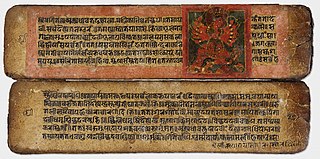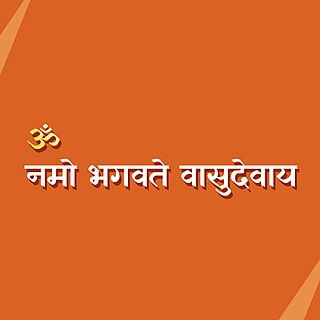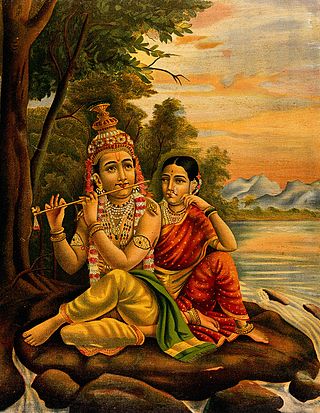Related Research Articles

In Hinduism, Kundalini is a form of divine feminine energy believed to be located at the base of the spine, in the muladhara. It is an important concept in Śhaiva Tantra, where it is believed to be a force or power associated with the divine feminine or the formless aspect of the Goddess. This energy in the body, when cultivated and awakened through tantric practice, is believed to lead to spiritual liberation. Kuṇḍalinī is associated with Parvati or Adi Parashakti, the supreme being in Shaktism; and with the goddesses Bhairavi and Kubjika. The term, along with practices associated with it, was adopted into Hatha yoga in the 9th century. It has since then been adopted into other forms of Hinduism as well as modern spirituality and New age thought.
Ghanananda Saraswati, commonly known as Swami Ghanananda, was a prominent swami (sannyasi) of the indigenous Hindu community in Ghana, and the first Hindu swami of African ancestry. He was initiated as a swami by the late Swami Krishnananda of India in 1975, and was head of the Hindu Monastery of Africa in Accra, Ghana.

Vishishtadvaita, is a school of Hindu philosophy belonging to the Vedanta tradition. Vedanta refers to the profound interpretation of the Vedas based on Prasthanatrayi. Vishishta Advaita, meaning "non-duality with distinctions", is a non-dualistic philosophy that recognizes Brahman as the supreme reality while also acknowledging its multiplicity. This philosophy can be characterized as a form of qualified monism, attributive monism, or qualified non-dualism. It upholds the belief that all diversity ultimately stems from a fundamental underlying unity.

The Devi Mahatmya or Devi Mahatmyam is a Hindu philosophical text describing the Goddess Durga/Adishakti as the supreme power and creator of the universe. It is part of the Markandeya Purana.

Bochasanwasi Akshar Purushottam Swaminarayan Sanstha is a Hindu denomination within the Swaminarayan Sampradaya. It was formed in 1905 by Yagnapurushdas following his conviction that Swaminarayan remained present on earth through a lineage of gurus starting with Gunatitanand Swami.

Vidyaranya, usually identified with Mādhavācharya, was the jagadguru of the Sringeri Sharada Peetham from ca. 1374–1380 until 1386 - according to tradition, after ordination at an old age, he took the name of Vidyaranya, and became the Jagadguru of this Matha at Sringeri.

The Divine Life Society (DLS) is a Hindu spiritual organization and an ashram, founded by Swami Sivananda Saraswati in 1936, at Muni Ki Reti, Rishikesh, India. Today Divine Life Society has branches around the world, with the headquarters situated in Rishikesh. Many disciples of Swami Sivananda have started independent organizations in Mauritius, the United States, Australia, Canada, Malaysia, South Africa, South America, and Europe.
The oral tradition of the Vedas (Śruti) consists of several pathas, "recitations" or ways of chanting the Vedic mantras. Such traditions of Vedic chant are often considered the oldest unbroken oral tradition in existence, the fixation of the Vedic texts (samhitas) as preserved dating to roughly the time of Homer.

Pramukh Swami Maharaj was the guru and Pramukh, or president, of the Bochasanwasi Akshar Purushottam Swaminarayan Sanstha (BAPS), a major branch of the Swaminarayan Sampradaya, a Hindu denomination. BAPS regards him as the fifth spiritual successor of Swaminarayan, following Gunatitanand Swami, Bhagatji Maharaj, Shastriji Maharaj, and Yogiji Maharaj. He was believed by his followers to be in constant communion with Swaminarayan, and ontologically, the manifestation of Akshar, the eternal abode of Swaminarayan.
Ahaṁkāra, 'I-making' is a Sanskrit term in Saṃkhyā philosophy that refers to the identification of Self or Being with 'Nature' or any impermanent 'thing'. It is referred to as ego and evolves from Mahat-tattva, It is one of the four Antaḥkaraṇa.

Purusha suktam is an interpolated hymn added to 10.90 of the Rigveda at a later period. It is dedicated to the Purusha, the "Cosmic Being".
The Sanskrit word bhava (भव) means being, worldly existence, becoming, birth, be, production, origin, but also habitual or emotional tendencies.

Nachiketa, also rendered Nachiketas and Nachiketan, is a character in Hindu literature. He is the son of the sage Vājashravas, or Uddalaki, in some traditions. He is the child protagonist of an ancient Indian, dialogical narrative, about the nature of the atman (soul).

Om Namo Bhagavate Vāsudevāyalit. '"I bow to the Ultimate Reality, Vāsudeva"' is one of the most popular Hindu mantras, and according to the Bhagavata tradition, the most important mantra in Vaishnavism. It is called the Dvadasakshari Mantra, or simply Dvadasakshari, meaning the "twelve-syllable" mantra, dedicated to Vishnu and Krishna both. It has two traditions—Tantric and Puranic. In the Tantric tradition, the rishi of the mantra is Prajapati; in the Puranic tradition, the rishi is Narada. Both refer to it as the supreme Vishnu mantra.

Ānanda literally means bliss or happiness. In the Hindu Vedas, Upanishads and Bhagavad gita, ānanda signifies eternal bliss which accompanies the ending of the rebirth cycle. Those who renounce the fruits of their actions and submit themselves completely to the divine will, arrive at the final termination of the cyclical life process (saṃsāra) to enjoy eternal bliss (ānanda) in perfect union with the godhead. The tradition of seeking union with God through loving commitment is referred to as bhakti, or devotion.
Panchadasi or Panchadashi is a simple yet comprehensive manual of Advaita Vedanta written in the fourteenth century CE (1386-1391) by Vidyaranya, previously known as Madhavacharya.

The Song of the Sannyasin is a poem of thirteen stanzas written by Swami Vivekananda. Vivekananda composed the poem in July 1895 when he was delivering a series of lectures to a groups of selected disciples at the Thousand Island Park, New York. In the poem he defined the ideals of Sannyasa or monastic life.
The Pavamana Mantra, also known as pavamāna abhyāroha is an ancient Indian mantra introduced in the Bṛhadāraṇyaka Upaniṣad (1.3.28.) The mantra was originally meant to be recited during the introductory praise of the soma sacrifice by the patron sponsoring the sacrifice.
Pariṇāmavāda, known in English as Transformation theory, is a Hindu philosophical theory which pre-supposes the cause to be continually transforming itself into its effects, and it has three variations – the Satkarya-vada of the Samkhyas, the Prakrti Parinama-vada of the Saiva Siddhanta and the Brahma-Parinama-vada of the Vishishtadvaita Vedanta School of Thought.

Akshar-Purushottam Darshan or Aksarabrahma-Parabrahma-Darsanam, "Akshar-Purushottam philosophy," is a designation used by BAPS as an alternative name for the Swaminarayan Darshana, Swaminarayan's view or teachings, to distinguish it from other Vedanta-traditions. It is based on Swaminarayan's distinction between Parabrahman and Aksharbrahman as two distinct eternal realities, which in this view sets Swaminarayan's teachings apart from other Vedanta-traditions. It is an essential element for the BAPS and it's Akṣara-Puruṣottama Upāsanā ("worship"), in which Purushottam c.q. Parabrahman is present in a lineage of Aksharbrahman guru's, who are the abode (akshar) of God.
References
- ↑ Subrahmanian
- ↑ Swami Krishnananda
- Subrahmanian Archived 2016-03-03 at the Wayback Machine
- Swami Krishnananda "THE NATURE OF THE INNER CONTROLLER"